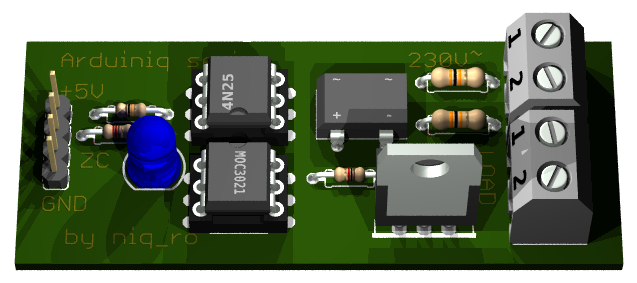I try more version, and now I present you a AC light dimmer with 2 push buttons for 16 steps and a alphanumerical LCD1602 display. I use 100W incandescent bulb at 230V/50Hz.
My schematic is:
For a good AC light dimmer, we need a zero cross detector and optocoupler who control a triac, like in this schematic (redesigned by me in Eagle PCB software after technical informations from https://arduinodiy.wordpress.com/2012/10/19/dimmer-arduino/):
My handmade module is:
In my case, I have 16 steps of intensity of bulb:
- bulb is off (0%):
- 1st step (6%):
- 2nd step (13%):
- 3rd step (19%):
- step no.4 (25%):
- stept no.5 (31%):
- step no. 6 (38%):
- step no.7 (44%):
- step no.8 (50%):
- step no.9 (57%):
- step no.10 (63%):
- step no.11 (69%):
- step no.12 (75%):
- step no.13 (82%):
- step no.14 (88%):
- step no.15 (94%):
- last step (100%), bulb is at maximum:
/*
AC Light Control
Updated by Robert Twomey <rtwomey@u.washington.edu>
Thanks to http://www.andrewkilpatrick.org/blog/?page_id=445
and http://www.hoelscher-hi.de/hendrik/english/dimmer.htm
adapted sketch by niq_ro from
http://www.tehnic.go.ro
http://www.niqro.3x.ro
http://nicuflorica.blogspot.com & http://arduinotehniq.blogspot.com
*/
#include <LiquidCrystal.h>
// use LiquidCrystal.h library for alphanumerical display 1602
LiquidCrystal lcd(13,12,11,10,9,8);
/* -------------------
| LCD | Arduino |
-------------------
LCD RS pin to digital pin 13 | RS | D13 |
LCD Enable pin to digital pin 12 | E | D12 |
LCD D4 pin to digital pin 11 | D4 | D11 |
LCD D5 pin to digital pin 10 | D5 | D10 |
LCD D6 pin to digital pin 9 | D6 | D9 |
LCD D7 pin to digital pin 8 | D7 | D8 |
LCD R/W pin to ground | R/W | GND |
-------------------
*/
#include <TimerOne.h> // Avaiable from http://www.arduino.cc/playground/Code/Timer1
volatile int i=0; // Variable to use as a counter
volatile boolean zero_cross=0; // Boolean to store a "switch" to tell us if we have crossed zero
int AC_pin = 3; // Output to Opto Triac
int buton1 = 4; // first button at pin 4
int buton2 = 5; // second button at pin 5
int dim2 = 0; // led control
int dim = 128; // Dimming level (0-128) 0 = on, 128 = 0ff
int pas = 8; // step for count;
// version: 4m7 (15.04.2013 - Craiova, Romania) - 16 steps, 4 button & LED blue to red (off to MAX)
// version: 7m3 (22.01.2014 - Craiova, Romania) - 16 steps, 2 button & LCD1602
int freqStep = 75; // This is the delay-per-brightness step in microseconds for 50Hz (change the value in 65 for 60Hz)
void setup() { // Begin setup
Serial.begin(9600);
pinMode(buton1, INPUT); // set buton1 pin as input
pinMode(buton2, INPUT); // set buton1 pin as input
pinMode(AC_pin, OUTPUT); // Set the Triac pin as output
attachInterrupt(0, zero_cross_detect, RISING); // Attach an Interupt to Pin 2 (interupt 0) for Zero Cross Detection
Timer1.initialize(freqStep); // Initialize TimerOne library for the freq we need
Timer1.attachInterrupt(dim_check, freqStep);
// Use the TimerOne Library to attach an interrupt
lcd.begin(16, 2); // set up the LCD's number of columns and rows:
lcd.clear(); // clear the screen
lcd.setCursor(2, 0); // put cursor at colon 0 and row 0
lcd.print("16 steps AC"); // print a text
lcd.setCursor(0, 1); // put cursor at colon 0 and row 1
lcd.print("dimmer for bulb"); // print a text
delay (3000);
lcd.clear(); // clear the screen
lcd.setCursor(1, 0); // put cursor at colon 0 and row 0
lcd.print("this sketch is"); // print a text
lcd.setCursor(1, 1); // put cursor at colon 0 and row 1
lcd.print("made by niq_ro"); // print a text
delay (3000);
lcd.clear(); // clear the screen
}
void zero_cross_detect() {
zero_cross = true; // set the boolean to true to tell our dimming function that a zero cross has occured
i=0;
digitalWrite(AC_pin, LOW);
}
// Turn on the TRIAC at the appropriate time
void dim_check() {
if(zero_cross == true) {
if(i>=dim) {
digitalWrite(AC_pin, HIGH); // turn on light
i=0; // reset time step counter
zero_cross=false; // reset zero cross detection
}
else {
i++; // increment time step counter
}
}
}
void loop() {
digitalWrite(buton1, HIGH);
digitalWrite(buton2, HIGH);
if (digitalRead(buton1) == LOW)
{
if (dim<127)
{
dim = dim + pas;
if (dim>127)
{
dim=128;
}
}
}
if (digitalRead(buton2) == LOW)
{
if (dim>5)
{
dim = dim - pas;
if (dim<0)
{
dim=0;
}
}
}
while (digitalRead(buton1) == LOW) { }
delay(10); // waiting little bit...
while (digitalRead(buton2) == LOW) { }
delay(10); // waiting little bit...
dim2 = 255-2*dim;
if (dim2<0)
{
dim2 = 0;
}
Serial.print("dim=");
Serial.print(dim);
Serial.print(" dim2=");
Serial.print(dim2);
Serial.print(" dim1=");
Serial.print(2*dim);
Serial.print('\n');
delay (100);
lcd.setCursor(2, 0); // put cursor at colon 0 and row 0
lcd.print("power is "); // print a text
lcd.print(100-100*(255-dim2)/255);
lcd.print("% "); // print a text
lcd.setCursor(1, 1); // put cursor at colon 0 and row 1
lcd.print("dim. level="); // print a text
lcd.print(dim);
lcd.print(" "); // print a text
}
NOTE: For 60Hz must change
int freqStep = 75;
in int freqStep = 65;
!
I made 2 movies with this AC light dimmer:
- ac light dimmer with Arduino (XVII)You can made PCB using lay file from http://arduinolab.pw and you can download Sprint Layout Viewer for open this file...























